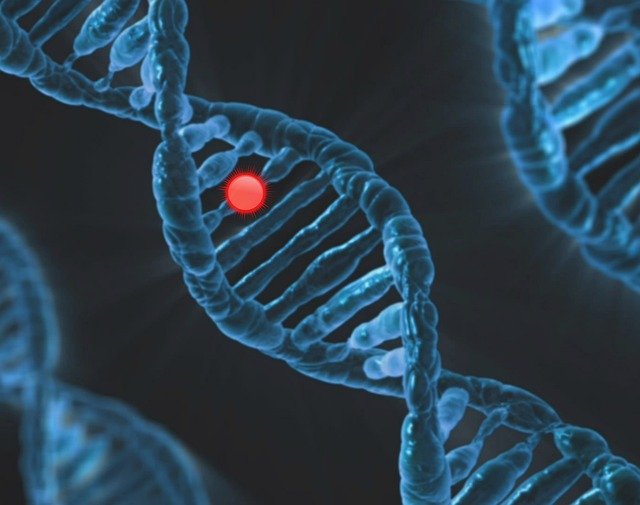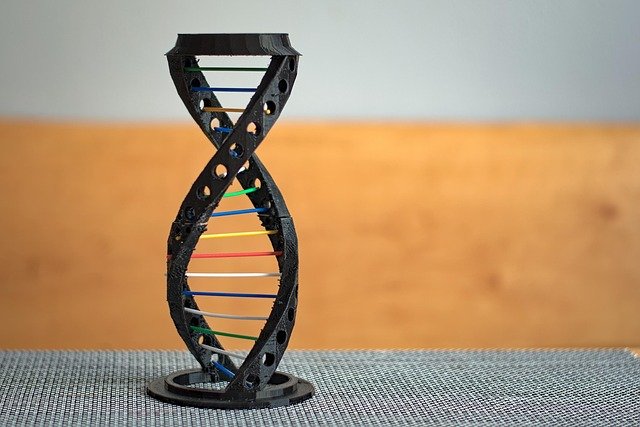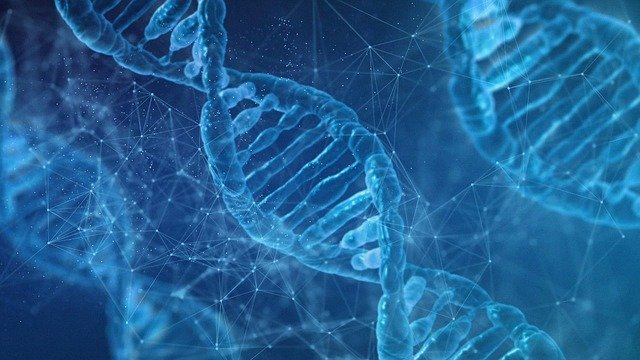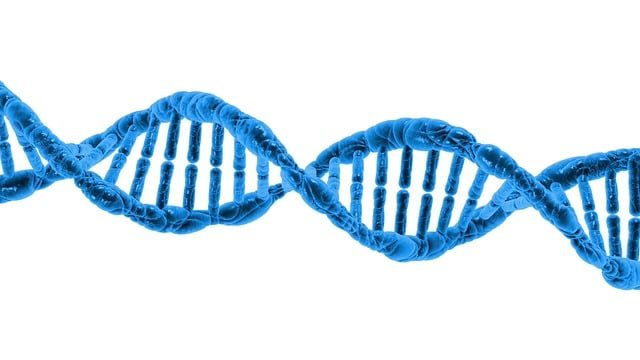Have you ever wondered why you look a little like your parents? Or why a puppy grows up to be a dog and not a cat? Or why a sunflower always grows into a sunflower and never into a rose?
The answer is hidden inside something so tiny, you can’t see it with your eyes. It’s called DNA.
DNA is like a secret code. It’s the set of instructions that tells every living thing how to grow, look, and work. You, me, your pet goldfish, the trees outside your window, even the tiniest insect—all of them have DNA.
Think of DNA as the world’s most important recipe book. Each recipe is written in a special language made of letters. These recipes decide everything: the color of your eyes, the shape of your nose, the size of a giraffe’s neck, and the spots on a ladybug’s back.
🧬 What Is DNA, Really?
DNA is short for DeoxyriboNucleic Acid. That name is long and sounds complicated, but don’t let it scare you. You can think of DNA as something very simple: the instructions for life.
Imagine you’re building a LEGO castle. Without the instruction sheet, you’d have no idea where each piece goes. DNA is like that instruction sheet—but instead of telling you where LEGO bricks go, it tells your body how to grow, work, and stay alive.
Without DNA, your body wouldn’t know how to make eyes, arms, or even blood. In fact, no living thing—plants, animals, or humans—could exist without it. DNA is what makes life possible.
🏠 Where Does DNA Live?
Your body is made of trillions of cells. A cell is like a tiny house. It has walls, doors, and little parts inside that do different jobs.
Now, inside most of these cells is a nucleus. Think of the nucleus as the “control room” of the cell, the place where the most important instructions are kept. That’s where DNA lives—tucked safely inside.
Here’s the cool part: almost every single cell in your body has a copy of the same DNA. The cells in your hair, your skin, your heart, and even your big toe all carry the exact same instruction manual.
So if your body were a city, with cells as houses, then DNA would be the mayor’s orders, delivered to every house so they all know how to do their job. That’s how your body works in harmony, with billions of cells following the same big plan.
🔄 What Does DNA Look Like?

At first, scientists thought DNA looked like a messy string. But when they looked closer, they discovered something breathtaking: DNA has the shape of a twisted ladder.
This shape is called a double helix. Imagine a spiral staircase that twists upward, step after step, reaching high. That’s what DNA looks like under a microscope.
The sides of this ladder (or staircase) are made of sugar and phosphate, which hold everything together. The steps are made of chemical “letters” that fit together in pairs, like puzzle pieces.
There are only four letters in DNA’s alphabet:
- A (Adenine)
- T (Thymine)
- C (Cytosine)
- G (Guanine)
These letters always pair the same way:
- A connects only with T.
- C connects only with G.
Think of them like best friends who never leave each other’s side. A will only hold hands with T, and C will only hold hands with G. That’s how the ladder stays strong and stable.
✍️ DNA as a Recipe Book
So why do these letters matter? Because when you line them up in different orders, they create words—just like letters in the alphabet form words in a sentence.
Those “words” in DNA are really recipes. Each recipe tells your body how to build something important: a protein.
Proteins are the building blocks of life. They make your muscles move, your skin protect you, your blood carry oxygen, and even your brain send signals.
Think of DNA as the world’s most important recipe book:
- The four letters (A, T, C, G) are the alphabet.
- The alphabet makes words (the recipes).
- The recipes make proteins.
- Proteins build you.
It’s incredible to realize that everything you are—your hair color, your smile, your height—is written in a language made up of only four letters. Four letters are all it takes to write the story of life.
How DNA Makes You Unique
If DNA is the instruction book for life, then every person has their own special copy. That’s why you look like you, and not exactly like anyone else.
Even though all human DNA is written with the same four letters (A, T, C, and G), the order of those letters is different for each person. Think of it like a story: the alphabet is the same, but the sentences and chapters are arranged differently. That’s what makes every story unique.
Your DNA is your story of life—and no one else has the exact same one.
🧒 Family Resemblance
You might notice you have the same eye color as your mom or the same smile as your dad. That’s because you inherit half your DNA from your mother and half from your father. It’s like combining two recipe books into one new, special edition.
That’s why you share similarities with your family, but you’re still your own person. Your brother or sister might look a bit like you, but not exactly. Each child gets a different mix of DNA, which is why siblings can look similar but also different at the same time.
👯 Identical Twins: The Special Case
There’s one exception—identical twins. They come from the same single cell that split in two. That means they have the exact same DNA code.
But even then, life adds little differences. For example, they might grow up with slightly different fingerprints, or one might get more freckles than the other. So while identical twins are almost carbon copies, nature still finds ways to make them unique.
🌍 Humans and Other Living Things
Here’s something mind-blowing: humans share a lot of their DNA with other living things.
- You share about 98–99% of your DNA with chimpanzees, which is why scientists say they’re our closest relatives in the animal world.
- You share about 50% of your DNA with bananas. Yes, bananas!
That doesn’t mean you’re half banana. It just means that many basic instructions for life are the same—like how to build cells or make energy.
So while DNA makes you unique, it also connects you to every living thing on Earth.
🧩 Tiny Differences, Big Impact
The difference between your DNA and someone else’s might be very small—sometimes less than 1%. But those tiny changes can affect big things, like your:
- Hair color
- Eye shape
- Height
- Voice
- Even how your body reacts to certain foods or medicines
It’s like baking cookies: a pinch more sugar or a little less flour, and suddenly you get a cookie that tastes a bit different. Your DNA has its own special “recipe tweaks” that make you you.
DNA is what makes the world so wonderfully diverse. From people to pets to plants, every creature is unique because of its DNA. And that uniqueness is what makes life so beautiful.
How DNA Works: Turning Code into Life
So far, we know DNA is like a recipe book filled with instructions. But how do those instructions actually work? How do letters on a DNA strand turn into the living, breathing you?
The answer is proteins. Proteins are the workers and builders of your body. DNA’s main job is to give your body the recipes to make them.
📖 Step 1: DNA Holds the Recipe
Inside your cells, DNA is like a big library filled with millions of recipes. Each recipe describes how to build a different protein.
For example:
- One recipe might tell your body how to make hemoglobin, a protein that carries oxygen in your blood.
- Another recipe might explain how to build keratin, which makes your hair and nails strong.
- Another could give the instructions for collagen, which keeps your skin flexible.
Every protein has its own special job—and DNA has the recipe for all of them.
📝 Step 2: Copying the Recipe
But here’s the thing: DNA is too precious to leave the nucleus. Remember, the nucleus is like the control room of the cell where DNA is stored.
So, when your cell needs a protein, it doesn’t take the DNA out. Instead, it makes a copy of the recipe. This copy is called RNA (RiboNucleic Acid).
Think of it like this: you don’t rip a page out of the library’s only copy of a book. You photocopy the recipe and take the copy to the kitchen. RNA is that photocopy.
🧑🍳 Step 3: Building the Protein
Once the RNA copy leaves the nucleus, it travels to another part of the cell called a ribosome. This is like the cell’s kitchen, where recipes are turned into real meals.
The ribosome reads the letters on the RNA (A, U, C, G—slightly different from DNA’s A, T, C, G) and puts together the right building blocks, called amino acids.
Amino acids are like beads. The ribosome strings them together in the right order, following the recipe exactly. When all the beads are in place, you have a protein!
🧱 Step 4: Proteins Build You
Now that the protein is made, it goes to work. Some proteins form structures—like muscles, skin, and bones. Others act like messengers, carrying signals around your body. Some even speed up chemical reactions so your body can digest food or fight germs.
Here’s a fun way to imagine it:
- DNA is the recipe book.
- RNA is the copied recipe card.
- Ribosomes are the kitchen.
- Amino acids are the ingredients.
- Proteins are the finished meals.
- And those meals? They keep you alive.
🌟 The Endless Cycle
This process—called the central dogma of biology (don’t worry about the fancy name!)—happens millions of times every second inside your body. Right now, as you read this, your cells are busy making proteins.
Without DNA giving instructions, your body wouldn’t know what to make. Without proteins, your body couldn’t grow, heal, or even think.
DNA isn’t just a code. It’s an active guide, constantly at work, keeping you alive.
Fun and Fascinating Facts About DNA

DNA is not just important—it’s also full of surprises. Here are some of the most amazing things about it:
📏 DNA Is Extremely Long
If you stretched out all the DNA in just one of your cells, it would be about 2 meters long—that’s taller than most people!
Now think about this: your body has trillions of cells. If you stretched out all the DNA in your whole body, it could reach from the Earth to the Sun and back—many times over.
So even though DNA is packed tightly into each tiny cell, if uncoiled, it would stretch across space. That’s how much information it holds!
🧳 DNA Is Packed Neatly into Chromosomes
Because DNA is so long, your body has to fold it up carefully to fit inside cells. It’s twisted, coiled, and folded again and again until it fits perfectly.
This packed DNA is organized into chromosomes. Humans usually have 46 chromosomes (23 pairs). You get 23 from your mom and 23 from your dad, making a complete set.
These chromosomes carry all your genes—the little sections of DNA that hold the recipes for different proteins.
🧩 DNA Is Almost the Same for Everyone
Here’s something amazing: humans are 99.9% the same at the DNA level. That means you and your best friend are almost identical in your genetic code.
But that tiny 0.1% difference? That’s what makes you unique—your face, your voice, your height, even the way your body works.
It’s wild to think that such a small change in DNA can create the huge variety we see in people all around the world.
🧬 DNA Can Be Read by Scientists
Scientists today have powerful machines that can “read” DNA. This process is called sequencing. It tells us the exact order of letters (A, T, C, G) in a piece of DNA.
By reading DNA, scientists can:
- Understand why people look different.
- Find out where diseases come from.
- Discover how plants and animals are related.
- Even trace human history and see where our ancestors lived thousands of years ago.
It’s like being able to peek inside the recipe book of life.
🍓 You Can Extract DNA at Home!
Here’s a fun fact: you can actually see DNA with your eyes—not from people, but from fruits like strawberries.
If you mash up strawberries and mix them with soap and rubbing alcohol, the DNA clumps together into white, stringy stuff that you can pull out. It looks like sticky threads.
That gooey white substance? That’s DNA—the same secret code that makes a strawberry a strawberry.
DNA isn’t just a boring molecule—it’s the most fascinating set of instructions in the world. It’s inside you, me, and every living thing. And the more you learn about it, the more magical life begins to feel.
Exploring DNA: Fun Activities for Kids

Learning about DNA doesn’t have to stay in a classroom or textbook. With a little creativity, kids can explore DNA at home, in the kitchen, or even outside. Here are some activities that make the “secret code of life” come alive.
1. See DNA with Your Own Eyes (Strawberry Experiment)
One of the coolest ways to understand DNA is to actually see it. And yes—you can do that at home using strawberries!
Here’s how:
- Mash up a few strawberries in a bag.
- Add a bit of dish soap. This breaks open the cells.
- Add a pinch of salt. This helps release the DNA.
- Strain the mush into a clear glass.
- Slowly pour rubbing alcohol down the side of the glass.
Within minutes, you’ll see white, stringy clumps floating up. That’s DNA—the secret code inside strawberries, now visible right in front of you.
Kids love this because it turns an invisible idea into something they can actually touch.
2. Build a DNA Model
Since DNA looks like a twisted ladder (a double helix), you can build your own version with simple materials.
Ideas:
- Use colored beads or candies for the four DNA letters (A, T, C, G).
- Use pipe cleaners or straws for the sides of the ladder.
- Twist it up like a spiral staircase.
As kids build, they can practice pairing A with T and C with G. It’s hands-on, creative, and helps the idea stick.
3. Play the Family Traits Game
DNA is what makes families share features. Kids can explore this by comparing traits in their family.
Ask questions like:
- Who has dimples?
- Who can roll their tongue?
- Who has attached earlobes?
Write down or draw the answers in a chart. This shows how certain traits “run in the family” because of DNA.
4. Draw Your DNA Story
DNA is unique for everyone, so let kids draw their own DNA story. Have them make a poster showing:
- Their eye color, hair type, and other traits.
- A picture of the DNA ladder with their name in the middle.
- Fun facts they’ve learned about how DNA works.
This makes DNA not just science, but a part of their identity.
5. Explore DNA in Nature
Remind kids that DNA isn’t just in people—it’s in every living thing. Go outside and collect leaves, flowers, or even look at bugs. Talk about how each one has DNA that tells it how to grow and survive.
You can even make a DNA treasure hunt: find three living things and guess what special instructions their DNA might have. For example:
- A bird’s DNA tells it how to fly.
- A flower’s DNA tells it what color petals to grow.
- A cat’s DNA tells it how to purr.
Activities like these turn DNA from a “big science word” into something real, touchable, and fun. They also build curiosity—the very first step in becoming a lifelong learner.
How Debsie Makes DNA Fun and Easy to Learn

At Debsie, we believe that big ideas—like DNA—shouldn’t feel scary or too complicated. Kids don’t need long, heavy textbooks to understand life’s secrets. What they need is storytelling, play, and a guide who makes it all click. That’s exactly what we do.
1. DNA as a Story, Not Just Science
Instead of memorizing “Deoxyribonucleic Acid,” we tell DNA’s story like a mystery adventure:
- DNA as a secret recipe book hidden in every cell.
- The four letters (A, T, C, G) as characters that always pair up like best friends.
- Proteins as the builders and workers who follow the recipes.
When kids hear it this way, they don’t just remember facts—they see DNA as a living, exciting world.
2. Learning Through Games
Children learn best when they’re active, not passive. So Debsie adds gamified challenges into DNA lessons. For example:
- DNA Matching Games – Students race to match A with T and C with G, building their own “DNA strands.”
- Role-Play Missions – One child plays the DNA, another plays RNA, and another plays the ribosome. Together, they act out how proteins are built.
- Trait Detectives – Students investigate their own family traits (like freckles, dimples, or curly hair) to see DNA in action.
These games don’t just teach—they make learning unforgettable.
3. Expert Teachers Who Bring DNA to Life
Our partner teachers are experienced scientists and educators. But here’s the secret: they explain in words children can actually understand.
Instead of saying “DNA codes for proteins,” they might say:
“DNA is like your body’s cookbook. Every recipe is a set of instructions, and proteins are the yummy meals that keep you alive.”
That simple shift makes science feel warm and clear, instead of overwhelming.
4. Hands-On Experiments, Even Online
Debsie lessons often include easy experiments kids can try at home—like the strawberry DNA activity. Teachers guide kids step-by-step, showing them how to extract DNA using everyday items from the kitchen.
When kids see DNA with their own eyes, they stop saying “DNA is hard.” Instead, they say, “Wow! I did science today.”
5. Connecting Science to Everyday Life
At Debsie, we also help kids see how DNA isn’t just something in a lab—it’s part of their daily lives.
- Why do you look like your parents? DNA.
- Why are there so many types of dogs? DNA.
- Why does a seed always grow into the same kind of plant? DNA.
When kids notice DNA everywhere, science stops being abstract. It becomes personal, relatable, and fun.
DNA can feel like a big idea, but at Debsie, we make it small, playful, and real. Kids walk away not only knowing what DNA is—but also feeling amazed by the story it tells inside every living thing.
Why Learning About DNA Matters for Kids’ Future

When kids learn about DNA, they’re not just memorizing facts for school—they’re unlocking the secret language of life itself. And this knowledge can open doors to so many important ideas.
1. DNA and Health
Your DNA plays a huge role in your health. Some health conditions are passed down through DNA, like eye color but also certain illnesses. By studying DNA, doctors can:
- Understand why some people get sick more easily.
- Find better treatments for diseases.
- Even prevent illnesses before they start.
When kids learn about DNA, they see how their choices—like eating well, exercising, and resting—can work together with their DNA to keep them strong.
2. DNA and Medicine
Scientists are using DNA to make new medicines that are smarter than ever. Some treatments can now be designed to match a person’s unique DNA—like a custom plan just for them.
For example:
- Cancer treatments can be targeted based on DNA.
- Doctors can check your DNA to know which medicines work best for your body.
When kids hear this, they realize DNA isn’t just science—it’s part of the future of medicine that could help them and their families.
3. DNA and Nature
DNA doesn’t just explain people—it explains the whole natural world.
- Why some animals can glow in the dark (like fireflies).
- Why some plants can survive in deserts.
- Why some insects have special colors to hide from predators.
By studying DNA, scientists protect endangered species, grow stronger crops, and even understand how to care for the planet better.
Kids who love animals, plants, or the environment can see DNA as a key to protecting the Earth.
4. DNA and Problem-Solving
Learning about DNA also teaches kids how to think like scientists. They learn to ask questions, make connections, and look for hidden patterns.
For example:
- Why do I look like my parents?
- Why are all cats cats, but no two cats are exactly the same?
- How can something so tiny decide everything about life?
These kinds of questions spark curiosity and problem-solving skills—the same skills kids will need in every part of their future, no matter what career they choose.
5. DNA and the Future of Science
Fields like genetics, biotechnology, and medicine are growing fast. The scientists of tomorrow—maybe even kids learning at Debsie today—could use DNA to:
- Cure diseases.
- Grow food for a hungry world.
- Discover life on other planets.
Learning DNA now means kids can dream bigger about what’s possible.
DNA isn’t just about the past or the present—it’s about the future. Teaching kids about DNA helps them see that science isn’t something far away in a lab. It’s right here, shaping their lives and the world they’ll grow up in.
Bringing DNA Learning to Life at Home
DNA might sound like something hidden deep inside a science lab, but the truth is—you can explore it right at home. With a few simple activities, kids can see, touch, and imagine the incredible code of life. These activities turn DNA from an abstract idea into something fun, playful, and memorable.
1. Extract DNA from Fruits
We touched on this earlier, but let’s expand it. One of the most magical things you can do is actually see DNA with your eyes. Fruits like strawberries, bananas, or kiwis have lots of DNA, and you can pull it out using simple household items.
All you need is:
- Dish soap (to break open the cells)
- Salt (to help DNA clump together)
- Rubbing alcohol (to separate DNA so you can see it)
When you mash, mix, and add the alcohol, you’ll see cloudy, white strands form. That goo is real DNA. Kids are always amazed—because suddenly DNA isn’t just something in a textbook. It’s right there, on the spoon!
2. Make a DNA Bracelet
DNA has four letters—A, T, C, and G. Each one can be represented by a different color bead. By stringing beads in certain patterns, kids can “code” their own DNA bracelet.
This activity helps children remember the base pairs (A with T, C with G), and at the end, they have something cool to wear—a personal “DNA strand” they made themselves.
3. Family Trait Hunt
DNA is what makes families share traits. Why not turn this into a game?
Sit together and look for traits like:
- Eye color
- Dimples
- Freckles
- Tongue-rolling ability
- Curly or straight hair
Make a chart to record who has what trait. Kids will see how DNA runs in families, but also how each person’s unique mix makes them special.
4. Draw a DNA Comic Strip
Ask your child to imagine DNA as a group of characters—A, T, C, and G. How do they pair up? What adventures do they go on? Maybe A and T are best friends who always stick together, while C and G team up to solve problems.
By turning DNA into a story, kids use creativity while reinforcing the rules of base pairing. Science becomes a mix of art and imagination.
5. DNA All Around Us
Finally, remind kids that DNA isn’t just inside people. It’s in everything that lives: the trees in your yard, your pet goldfish, the ants crawling on the sidewalk.
You can take a nature walk and ask questions like:
- “What does a butterfly’s DNA tell it to do?”
- “Why do flowers have different colors?”
- “What makes one bird sing differently than another?”
This helps kids connect DNA to the real world, so they see it as part of daily life, not just science class.
Final Thoughts: DNA—The Secret Code of Life
DNA may be too small to see with your eyes, but it carries the biggest story of all—the story of life itself. From the shape of your nose to the way a sunflower grows, DNA holds the instructions that make every living thing unique and connected.
It’s amazing to think that just four letters—A, T, C, and G—write the recipe for all plants, animals, and humans on Earth. With those letters, life has created endless variety, from buzzing bees to towering trees to you.
For kids, learning about DNA isn’t just about science—it’s about discovery. It’s about asking: Why am I the way I am? Why does the world look like this? What makes each of us special? These questions light up curiosity, and curiosity is the spark that makes learning powerful.
At Debsie, that’s exactly what we do. We turn big, sometimes intimidating ideas like DNA into fun stories, exciting experiments, and adventures kids can actually experience. We know kids learn best when they’re engaged, when they can play, create, and ask questions freely. That’s why our science lessons are never just about memorizing facts—they’re about building wonder, confidence, and real understanding.
Read Next:
